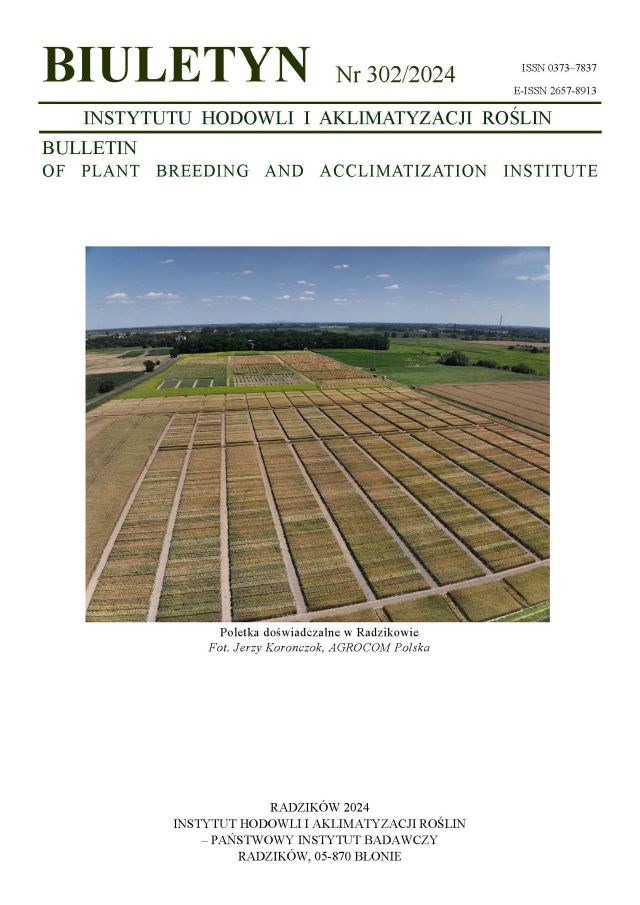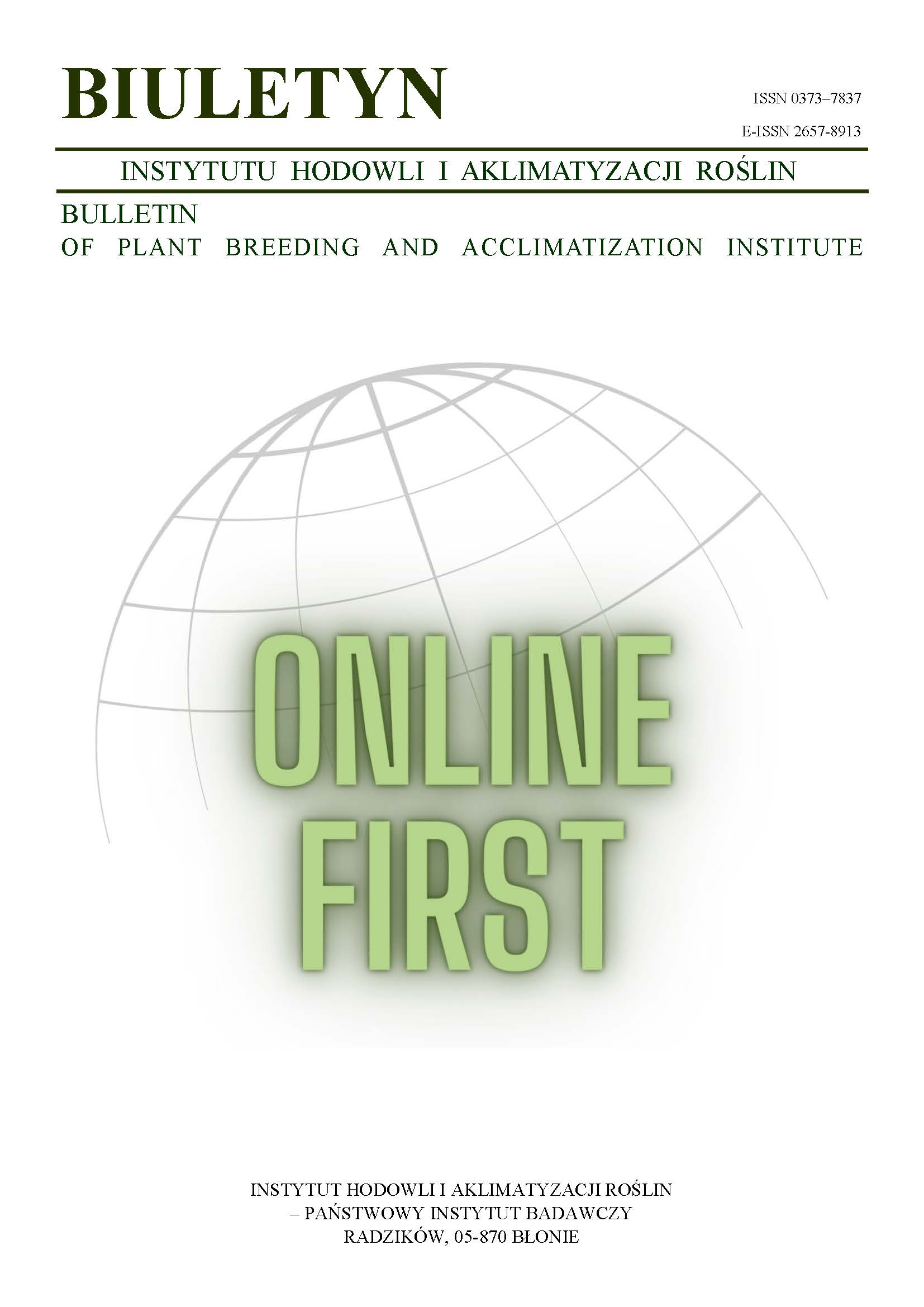Heterosis for Seed Yield Related Traits in Brassica napus L. Hybrids - Preliminary Studies
M. Sakibur Alam
Department of Genetics and Plant Breeding, Bangabandhu Sheikh Mujibur Rahman Agricultural University, Gazipur 1706 (Bangladesh)
M.S. Raihan
Department of Genetics and Plant Breeding, Bangabandhu Sheikh Mujibur Rahman Agricultural University, Gazipur 1706 (Bangladesh)
M.M. Haque
Department of Agronomy, Bangabandhu Sheikh Mujibur Rahman Agricultural University, Gazipur 1706 (Bangladesh)
A. K. M. Aminul Islam
aminulgpb@bsmrau.edu.bdDepartment of Genetics and Plant Breeding, Bangabandhu Sheikh Mujibur Rahman Agricultural University, Gazipur 1706 (Bangladesh)
https://orcid.org/0000-0001-8270-5968
Abstrakt
An experiment was conducted to evaluate 14 selected hybrids of Brassica napus L. with their 10 pollen parents and two varieties (BARI Sarisha-13, 18) as standard check for seed yield related traits. The experiment was laid out in Randomized Complete Block Design (RCBD) with three replications. The analysis of variance showed significant variability among the genotypes for studied traits. It was also evident for the estimates of heterosis over pollen parent and standard checks, several hybrids exhibited heterosis in desirable directions for most of the yield related traits. The highest magnitude of heterosis (70.64%) over pollen parent was observed in the hybrid 248A×001(3) for number of siliqua per plant. Besides, the highest pollen parent heterosis (58.24%) in positive direction was found for hundred seed weight (g) in hybrid 248A×30(2). The estimates of standard heterosis for the experimental hybrids revealed that the hybrid 206A×004(1) and 248A×004(1) exhibited the highest negative heterosis ((-13.95% and -11.62%, respectively) for days to flowering and seeds per siliqua, and the hybrid 248A×001(3) for plant height (-22.08%). For number of siliqua per plant, the hybrids 248A×017(1) (114.41%) and 206A×001(2) (106.11%) exhibited the highest significant standard heterosis over both checks. The hybrids 248A×30(2) produced the heaviest seed (48.45%) and 206A×017(1) and 206A×001(2) produced the highest seed yield per plant (90.20% and 89.40%, respectively) which was exhibited from their significant positive heterosis (48.45%). In conclusion, the hybrids could be selected as promising hybrid combinations and forwarded for CMS based hybrid variety development of Brassica napus.
Słowa kluczowe:
rapeseed, hybrid, CMS line, pollen parent, check variety, standard heterosisBibliografia
Abideen, S.N.U., Nadeem, F., and Abideen, S.A. 2013. Genetic variability and correlation studies in rapeseed (Brassica napus L.) genotypes. Int J Inn Appl Studies, 2(4), 574-581.
Google Scholar
Anum, H.H., Waseem, H.M., Awais, M., Tabusam, J., Hafiza, B.S., Asim, M., Raza, M.H.A., 2019. Heterosis study of agronomic characters of Brassica napus L. Nature and Science 17(8), 71-78.
Google Scholar
Azim, J.B., Chowdhury, N., Khan Robin, A.H., 2024. Combining ability and heterosis studies for yield improvement in rapeseed (Brassica napus). Research Square. https://doi.org/10.21203/rs.3.rs-4818498/v1.
DOI: https://doi.org/10.21203/rs.3.rs-4818498/v1
Google Scholar
Barupal, H.L., Sharma, A.K., Shekhawat, H.S., Kumar, P., Kumar, M., 2017. Heterosis Studies in Indian mustard [Brassica Juncea]. International Journal of Agricultural Innovation and Research, 5(6), 1473-2319.
Google Scholar
Bharti, R., Gupta, S.K., Chaudhary, N., and Rai, S.K., 2018. Estimate the relative heterosis and heterobeltiosis for yield components in Indian mustard [Brassica juncea (L.) Czern and Coss]. International Journal of Engineering Sciences and Research Technology, 3, 682-691.
Google Scholar
Chalhoub, B., Denoeud, F., Liu, S., Parkin, I.A., Tang, H., Wang, X., Wincker, P., 2014. Early allopolyploid evolution in the post-Neolithic Brassica napus oilseed genome. Science, 345(6199), 950-953.
DOI: https://doi.org/10.1126/science.1253435
Google Scholar
Channa, S.A., Tian, H., Mohammed, M.I., Zhang, R., Faisal, S., Guo, Y., Hu, S., 2018. Heterosis and combining ability analysis in Chinese semi-winter × exotic accessions of rapeseed (Brassica napus L.). Euphytica, 214(8), 134.
DOI: https://doi.org/10.1007/s10681-018-2216-1
Google Scholar
Dina, M.M.A., Sultana, S., Bhuiyan, M.S.U., 2019. Development of high frequency in vitro plant regeneration protocol of Brassica napus. Journal of Advanced Biotechnology and Experimental Therapeutics 2, 114-119.
DOI: https://doi.org/10.5455/jabet.2019.d33
Google Scholar
Fatima, N., Hassan, M., Sarowar, S., 2022. Combining Ability and Heterosis Analysis for Seed Yield Related Traits in Brassica Napus. Journal of Global Innovations in Agriculture, 10(4), 179-190.
DOI: https://doi.org/10.22194/JGIAS/10.1021
Google Scholar
Filipova, M., Zheleva, I., Sulejmenova, N., Abildaev, E., 2017. An analysis of growth factors of rapeseed at modern resource-saving technology. AIP Conference Proceedings 1895, 030001.
DOI: https://doi.org/10.1063/1.5007360
Google Scholar
Fridrihsone, A., Romagnoli, F., Cabulis, U., 2020. Environmental life cycle assessment of rapeseed and rapeseed oil produced in Northern Europe: A Latvian case study. Sustainability, 12(14), 5699.
DOI: https://doi.org/10.3390/su12145699
Google Scholar
Guang, L.U., Zhang, F., and Zheng, P. 2011. Relationship among yield components and selection criteria for yield improvement in early rapeseed (Brassica napus L.). J. Int. Agric., 10(7), 997-1003.
DOI: https://doi.org/10.1016/S1671-2927(11)60086-2
Google Scholar
Helal, M.M.U., Islam, D.M.N., Biswas, D.M., Kadir, D.M., Miah, D.M.N.H., 2022. Performance of rapeseed and mustard (Brassica sp.) Varieties/lines in north-east region (Sylhet) of Bangladesh. Sci. J. Seoul Sci., 4(2), 6-13.
Google Scholar
Islam, A.K.M.A., Chowdhury, N.K., Era, F.M., Rasul, M.G., 2020b. Interrelationships among grain yield and related traits of candidate restorer lines of Brassica napus L. Annals of Bangladesh Agriculture, 24(1), 51-64. https://doi.10.3329/aba.v24i1.51935.
DOI: https://doi.org/10.3329/aba.v24i1.51935
Google Scholar
Islam, A.K.M.A., Era, F.M., Chowdhury, N.K., 2020a. Production of Restorer Lines from Segregating Progenies of Brassica napus L. Having Good Agronomic Value. Int. J. Appl. Sci. Biotechnol., 8(4), 400-409. https://doi.org/10.3126/ijasbt.v8i4.31352.
DOI: https://doi.org/10.3126/ijasbt.v8i4.31352
Google Scholar
Karim, A.N.M.S., Ahmed, S., Akhi, A.H., Talukder, M.Z.A., 2018. Combining ability and heterosis study in maize (Zea mays L.) Hybrids at different environments in Bangladesh. Bangladesh Journal of Agricultural Research, 43(1), 125-134.
DOI: https://doi.org/10.3329/bjar.v43i1.36186
Google Scholar
Kaur, S., Kumar, R., Kaur, R., Singh, I., Singh, H., Kumar, V., 2019. Heterosis and combining ability analysis in Indian mustard (Brassica juncea L.). Journal of Oilseed Brassica, 10(1), 38-46.
DOI: https://doi.org/10.31901/24566535.2019/10.1-2.122
Google Scholar
Khaleque, M.A., 1985. A Guide Book on Production of Oil crops in Bangladesh. DAE and FAO/UNDP Project BGD/79/034, ‘Strengthening the Agricultural Extension Service’ Khamarbari, Farmgate, Dhaka, p. 3.
Google Scholar
Khan, M.H., Kundu, B.C., Uddin, M.S., 2023. Yield potency assessment and characters association of promising lines of mustard (Brassica rapa L.) in southern region of Bangladesh. Advances in Modern Agriculture, 4(2), 2216.
DOI: https://doi.org/10.54517/ama.v4i2.2216
Google Scholar
Khatun, M.U.S., Ferdous, Z., Haque, Z., Alam, M.A.U., Hasan, M., Islam, M.K., 2019. Increasing cropping intensity of Fallow Boro-T. Aman cropping pattern with inclusion of mustard in Tista Mender flood plain soil. Progressive Agriculture, 30, 360-370.
DOI: https://doi.org/10.3329/pa.v30i4.46895
Google Scholar
Laghari K., Baloch, M., Sootaher, J.K., Menghwar, K.K., Kachi, M., Kumbhar, Z.M., Shah, W.H., Soothar, M.K., and Daudpotto, I. 2020. Correlation and heritability analysis in rapeseed (Brassica napus L.) genotypes. Pure and Applied Biology, 9(1), 507-516.
DOI: https://doi.org/10.19045/bspab.2020.90056
Google Scholar
Liton, M.U.A., Bhuiyan, M.S.R., Zeba, N., and Rashid, M.H., 2017. Estimation of Heterosis for Yield and Its Attributes in Brassica rapa L. Asian Research Journal of Agriculture, 4(4), 1-13.
DOI: https://doi.org/10.9734/ARJA/2017/33085
Google Scholar
Liu, H., Wang, J., Zhang, B., Yang, X., Yuan, P., Ding, G., Shi, L., 2022. Genome-wide association study identifies new loci for 1000-seed weight in Brassica napus. Euphytica, 218(10), 142.
DOI: https://doi.org/10.1007/s10681-022-03097-7
Google Scholar
Malek, M.A., Ismail, M.R., Monshi, F.I., Mondal, M.M.A., Alam, M.N., 2012. Selection of promising rapeseed mutants through multilocation trials. Bangladesh Journal Botany, 41, 111-114.
DOI: https://doi.org/10.3329/bjb.v41i1.11089
Google Scholar
Meena, H.S., Kumar, A., Singh, V.V., Meena, P.D., Ram B., and Kulshrestha S. 2017. Genetic variability and inter-relation of seed yield with contributing traits in Indian mustard (Brassica juncea). J. Oilseed Bras. 8(2), 131-137.
Google Scholar
Miah, M.A., Rasul, M.G., Mian, M.A.K., Rohman, M.M., 2015. Evaluation of rapeseed lines for seed yield stability. International Journal of Agronomy and Agricultural Research, 7, 12-19.
Google Scholar
Nassimi, A.W., Ali, S., and Ali, N., 2006. Study on heterosis in agronomic characters of rapeseed (Brassica napus L.) using diallel. Journal of Agronomy, 5(3), 505-508.
DOI: https://doi.org/10.3923/ja.2006.505.508
Google Scholar
Panse, V.G., Sukhatme P.V., 1957. Genetics of quantitative characters in relation to plant breeding. Indian Journal of Genetics, 17(2), 318-328.
Google Scholar
Raboanatahiry, N., Li, H., Yu, L., Li, M., 2021. Rapeseed (Brassica napus): Processing, utilization, and genetic improvement. Agronomy, 11(9), 1776.
DOI: https://doi.org/10.3390/agronomy11091776
Google Scholar
Radoev, M., Becker, H.C., Ecke, W., 2008. Genetic analysis of heterosis for yield and yield components in rapeseed (Brassica napus L.) by quantitative trait locus mapping. Genetics, 179(3), 1547-1558.
DOI: https://doi.org/10.1534/genetics.108.089680
Google Scholar
Saha, S.C., Yeasmin, S., Islam, A.K.M.A., Rasul, M.G., Mian, M.A.K., 2011. Performance of source nursery of pollen parent and CMS lines of Brassica napus L. Journal of Agricultural Science, 3(2), 114-122.
DOI: https://doi.org/10.5539/jas.v3n2p114
Google Scholar
Sarkar, S., Monshi, F.I., Uddin, M.R., Tabassum, R., Sarkar, M.J., Hasan, A.K., 2021. Source-sink manipulation influences the grain-filling characteristics associated with the grain weight of rice. Journal of Innovative Agriculture, 8, 20- 29.
DOI: https://doi.org/10.37446/jinagri/rsa/8.4.2021.20-29
Google Scholar
Saroj, R., Soumya, S.L., Singh, S., Sankar, S.M., Chaudhary, R., Yashpal, Yadava, D.K., 2021. Unraveling the relationship between seed yield and yield-related traits in a diversity panel of Brassica juncea using multi-traits mixed model. Frontiers in Plant Science, 12, 651936.
DOI: https://doi.org/10.3389/fpls.2021.651936
Google Scholar
Singh, R.K., Chaudhary, B.D., 1985. Biometrical Methods in Quantitative Genetic Analysis. Kalyani.
Google Scholar
Song, J.M., Guan, Z., Hu, J., Guo, C., Yang, Z., Wang, S., Liu, D., Wang, B., Lu, S., Zhou, R., Xie, W.Z., Cheng, Y., Zhang, Y., Liu, K., Yang, Q.Y., Chen, L.L., Guo, L., 2020. Eight high-quality genomes reveal pan-genome architecture and ecotype differentiation of Brassica napus. Nature Plants, 6(1), 34-45. https://doi.org/10.1038/s41477-019-0577-7
DOI: https://doi.org/10.1038/s41477-019-0577-7
Google Scholar
Surin, S., Kumar, A., Kumari, S., Kumar, Y., Tuti, A., Suman, A., 2018. Heterosis for Yield and Its Component in Indian mustard (Brassica juncea (L.) Czern & Coss). International Journal of Current Microbiology and Applied Science, 7, 3866-3871.
Google Scholar
Talukder, A.H.M.M.R., Biswas, M., Miah, M.N.H., Kashem, M.A., Nahar, L., 2020. Effect of harvesting stages on seed and oil yield of rapeseed-mustard to suitable in a cropping pattern. International Journal of Plant and Soil Science, 32, 1-10.
DOI: https://doi.org/10.9734/ijpss/2020/v32i230240
Google Scholar
Tariq, H, Tanveer, S.K, Qamar, M., Javaid, R.A., Vaseer, S.G., Jhanzab, H.M., Hassan, M.J., and Iqbal, H. 2020. Correlation and path analysis of Brassica napus genotypes for yield related traits. Life Sci J., 17(8), 22-34.
Google Scholar
USDA. 2024. United States Department of Agriculture, Foreign Agricultural Services, Oilseeds and Products Annual of Bangladesh, 3p.
Google Scholar
Wang, Q., Yan, T., Long, Z., Huang, L.Y., Zhu, Y., Xu, Y., Jiang, L., 2021. Prediction of heterosis in the recent rapeseed (Brassica napus) polyploid by pairing parental nucleotide sequences. PLoS Genetics, 17(11), 1009879.
DOI: https://doi.org/10.1371/journal.pgen.1009879
Google Scholar
Yesmin, M. A., Salim, M., Monshi, F.I., Hasan, A.K., Hannan, A., Islam, S.S., and Tabassum, R., 2022. Morpho-physiological and genetic characterization of transplanted Aman rice varieties under old Brahmaputra flood plain (AEZ-9) in Bangladesh. Tropical Agricultural Research and Extension, 25, 71-84.
DOI: https://doi.org/10.4038/tare.v25i1.5573
Google Scholar
Autorzy
M. Sakibur AlamDepartment of Genetics and Plant Breeding, Bangabandhu Sheikh Mujibur Rahman Agricultural University, Gazipur 1706 Bangladesh
Autorzy
M.S. RaihanDepartment of Genetics and Plant Breeding, Bangabandhu Sheikh Mujibur Rahman Agricultural University, Gazipur 1706 Bangladesh
Autorzy
M.M. HaqueDepartment of Agronomy, Bangabandhu Sheikh Mujibur Rahman Agricultural University, Gazipur 1706 Bangladesh
Autorzy
A. K. M. Aminul Islamaminulgpb@bsmrau.edu.bd
Department of Genetics and Plant Breeding, Bangabandhu Sheikh Mujibur Rahman Agricultural University, Gazipur 1706 Bangladesh
https://orcid.org/0000-0001-8270-5968
Statystyki
Abstract views: 32PDF downloads: 14
Licencja
Prawa autorskie (c) 2024 M. Sakibur Alam, M.S. Raihan, M.M., A. K. M. Aminul Islam

Utwór dostępny jest na licencji Creative Commons Uznanie autorstwa – Na tych samych warunkach 4.0 Miedzynarodowe.
Z chwilą przekazania artykułu, Autorzy udzielają Wydawcy niewyłącznej i nieodpłatnej licencji na korzystanie z artykułu przez czas nieokreślony na terytorium całego świata na następujących polach eksploatacji:
- Wytwarzanie i zwielokrotnianie określoną techniką egzemplarzy artykułu, w tym techniką drukarską oraz techniką cyfrową.
- Wprowadzanie do obrotu, użyczenie lub najem oryginału albo egzemplarzy artykułu.
- Publiczne wykonanie, wystawienie, wyświetlenie, odtworzenie oraz nadawanie i reemitowanie, a także publiczne udostępnianie artykułu w taki sposób, aby każdy mógł mieć do niego dostęp w miejscu i w czasie przez siebie wybranym.
- Włączenie artykułu w skład utworu zbiorowego.
- Wprowadzanie artykułu w postaci elektronicznej na platformy elektroniczne lub inne wprowadzanie artykułu w postaci elektronicznej do Internetu, lub innej sieci.
- Rozpowszechnianie artykułu w postaci elektronicznej w internecie lub innej sieci, w pracy zbiorowej jak również samodzielnie.
- Udostępnianie artykułu w wersji elektronicznej w taki sposób, by każdy mógł mieć do niego dostęp w miejscu i czasie przez siebie wybranym, w szczególności za pośrednictwem Internetu.
Autorzy poprzez przesłanie wniosku o publikację:
- Wyrażają zgodę na publikację artykułu w czasopiśmie,
- Wyrażają zgodę na nadanie publikacji DOI (Digital Object Identifier),
- Zobowiązują się do przestrzegania kodeksu etycznego wydawnictwa zgodnego z wytycznymi Komitetu do spraw Etyki Publikacyjnej COPE (ang. Committee on Publication Ethics), (http://ihar.edu.pl/biblioteka_i_wydawnictwa.php),
- Wyrażają zgodę na udostępniane artykułu w formie elektronicznej na mocy licencji CC BY-SA 4.0, w otwartym dostępie (open access),
- Wyrażają zgodę na wysyłanie metadanych artykułu do komercyjnych i niekomercyjnych baz danych indeksujących czasopisma.
Inne teksty tego samego autora
- K. Naher Ruma, M. S. Raihan, M. A. Hoque, A. K. M. Aminul Islam, General and Specific Combining Ability for Fruit Yield Using Diallel Population of Ridge Gourd (Luffa acutangula (Roxb.) L.) , Biuletyn Instytutu Hodowli i Aklimatyzacji Roślin: Nr 301 (2024): Wydanie regularne














